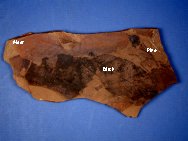Alder,
Birch and Pine Plant Fossils
Alder: Division
Magnoliophyta, Order Fagales, Family Betulaceae, Genus Alnus
Birch: Division Magnoliophyta, Order Fagales, Family Betulaceae, Genus
Betula
Pine: Division Pinophyta, Class Pinopsida, Order Pinales, Family Pinaceae,
Genus Pinus
Geological
Time: Middle Eocene
Size (25.4mm=1
inch): Shale is 170 by 65 mm
Fossil Site:
McAbee Quarry; Cache Creek, Tranquille Shale, Kamloops Group, British
Columbia, Canada
Code: CP29
Price: $30.00
|  Coming
from the Tranquille Shale in British Columbia, Canada, this Middle
Eocene plant fossil plate represents some of the defining events
of Paleobiology in the Tertiary (see discussion below). It contains
a large well-preserved magnolia leaf with many fine details, venation
and stem preserved, and partials of two other leaves forming a mosaic
display. Plants of family Magnoliidae are among the most primitive
angiosperms, the flowering plants. Coming
from the Tranquille Shale in British Columbia, Canada, this Middle
Eocene plant fossil plate represents some of the defining events
of Paleobiology in the Tertiary (see discussion below). It contains
a large well-preserved magnolia leaf with many fine details, venation
and stem preserved, and partials of two other leaves forming a mosaic
display. Plants of family Magnoliidae are among the most primitive
angiosperms, the flowering plants.
The
Eocene was a period when flowering plants continued a massive radiation
that began in the Paleocene Epoch. Plants thrived, and with that
many animals, as new environmental niches were filled. The first
grasses appeared with growth near the root as opposed to the tip,
providing a renewable food resource and place of refuge for many
animals. Small mammals radiated. Many new species of shrubs, trees
and small plants appeared. A variety of trees thrived in a warm
Eocene climate, including beech, elm, chestnut, magnolia, redwood,
birch, and cedar, and more. The evolution of plants was providing
a powerful selective pressure across the entire animal Kingdom,
and many new symbiotic systems appeared.
|
|
